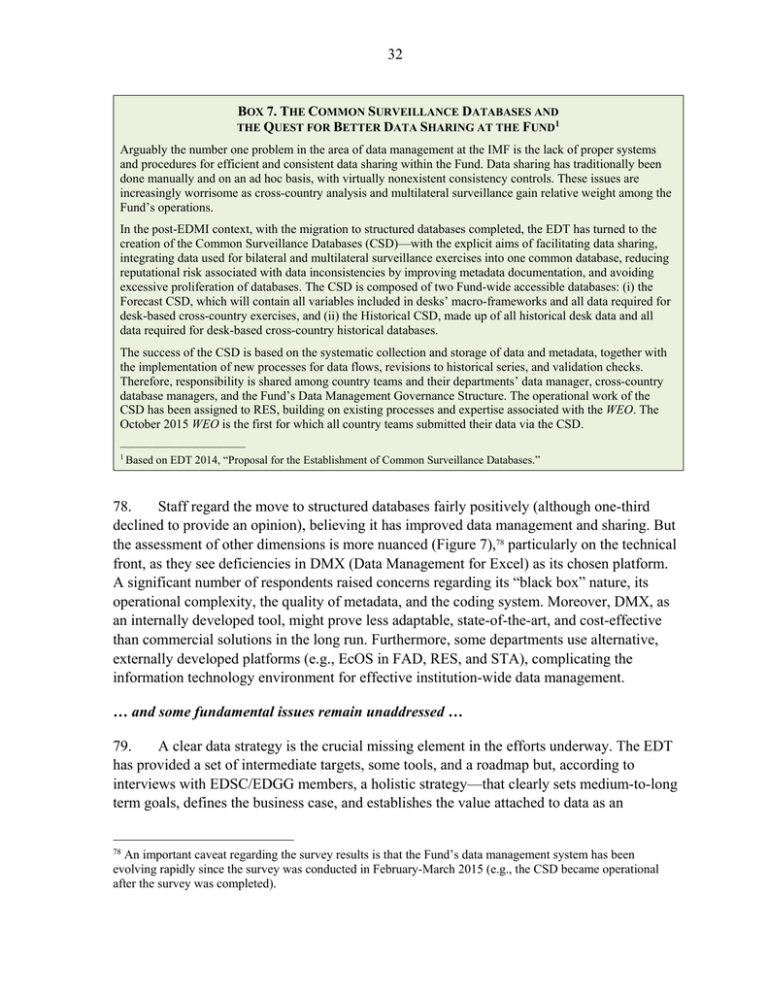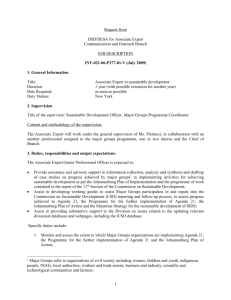7. The Common Surveillance Databases and the Quest for Better
advertisement

32 BOX 7. THE COMMON SURVEILLANCE DATABASES AND THE QUEST FOR BETTER DATA SHARING AT THE FUND1 Arguably the number one problem in the area of data management at the IMF is the lack of proper systems and procedures for efficient and consistent data sharing within the Fund. Data sharing has traditionally been done manually and on an ad hoc basis, with virtually nonexistent consistency controls. These issues are increasingly worrisome as cross-country analysis and multilateral surveillance gain relative weight among the Fund’s operations. In the post-EDMI context, with the migration to structured databases completed, the EDT has turned to the creation of the Common Surveillance Databases (CSD)—with the explicit aims of facilitating data sharing, integrating data used for bilateral and multilateral surveillance exercises into one common database, reducing reputational risk associated with data inconsistencies by improving metadata documentation, and avoiding excessive proliferation of databases. The CSD is composed of two Fund-wide accessible databases: (i) the Forecast CSD, which will contain all variables included in desks’ macro-frameworks and all data required for desk-based cross-country exercises, and (ii) the Historical CSD, made up of all historical desk data and all data required for desk-based cross-country historical databases. The success of the CSD is based on the systematic collection and storage of data and metadata, together with the implementation of new processes for data flows, revisions to historical series, and validation checks. Therefore, responsibility is shared among country teams and their departments’ data manager, cross-country database managers, and the Fund’s Data Management Governance Structure. The operational work of the CSD has been assigned to RES, building on existing processes and expertise associated with the WEO. The October 2015 WEO is the first for which all country teams submitted their data via the CSD. —————————— 1 Based on EDT 2014, “Proposal for the Establishment of Common Surveillance Databases.” 78. Staff regard the move to structured databases fairly positively (although one-third declined to provide an opinion), believing it has improved data management and sharing. But the assessment of other dimensions is more nuanced (Figure 7),78 particularly on the technical front, as they see deficiencies in DMX (Data Management for Excel) as its chosen platform. A significant number of respondents raised concerns regarding its “black box” nature, its operational complexity, the quality of metadata, and the coding system. Moreover, DMX, as an internally developed tool, might prove less adaptable, state-of-the-art, and cost-effective than commercial solutions in the long run. Furthermore, some departments use alternative, externally developed platforms (e.g., EcOS in FAD, RES, and STA), complicating the information technology environment for effective institution-wide data management. … and some fundamental issues remain unaddressed … 79. A clear data strategy is the crucial missing element in the efforts underway. The EDT has provided a set of intermediate targets, some tools, and a roadmap but, according to interviews with EDSC/EDGG members, a holistic strategy—that clearly sets medium-to-long term goals, defines the business case, and establishes the value attached to data as an 78 An important caveat regarding the survey results is that the Fund’s data management system has been evolving rapidly since the survey was conducted in February-March 2015 (e.g., the CSD became operational after the survey was completed).



